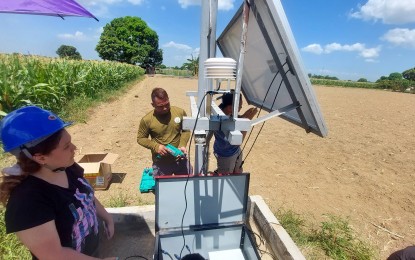
Installation of WEHLO (Localized Weather, Environment and Hydromet Monitoring System) in one of the villages in Angat, Bulacan (Photo courtesy of MDRRMO-Angat Facebook)
MANILA – The Department of Science and Technology (DOST) and the Mapua University launched in Manila on Friday a localized weather monitoring system the latter has developed.
Funded by the DOST-Philippine Council for Industry, Energy, and Emerging Technology Research and Development (PCIEERD) for PHP15 million, the WEHLO (Localized Weather, Environment, and Hydromet) Monitoring System was developed by an engineering team from Mapua University.
In an interview with the Philippine News Agency, PCIEERD Director Enrico Paringit said the WEHLO's intended users are local government units (LGUs) and their Disaster Risk Reduction and Management Offices, but the system can also be offered to other agencies and private sectors needing customized weather and hazard information.
"It not just sends the weather forecast, but gives focus on the effects of heavy rains. It will send analytics on whether there might be flooding or landslides, the areas at risk, the duration. A map would also appear," he said.
The data will be transmitted via web, short messaging system (text) or social media, he added.
Paringit clarified that although WEHLO is unmanned, it follows the standards of the World Meteorological Organization and the Philippine Atmospheric, Geophysical and Astronomical Services Administration (PAGASA), which will also automatically receive every data that WEHLO would transmit.
"The WEHLO would capture the local [weather conditions] and would provide advice and warning to specific areas," he said.
Paringit emphasized that WEHLO would augment LGUs’ preparedness, especially since there are not enough PAGASA stations.
Earlier, Deputy Administrator Marcelino Villafuerte II told the PNA there are many areas that don't have a PAGASA station since putting one up would require a lot of resources.
There are 82 PAGASA stations, mostly located in the cities, and 100 automatic or unmanned stations.
With the upcoming La Niña, Paringit said WEHLO is essential as this would provide correct and localized advisories on forecast rainfall.
"Because we expect that La Niña would cause heavy and widespread rains that may result in floods and landslides. It is important that communities are prepared on the hazards and risks," he said.
Validation tests were already conducted by the WEHLO team with the LGUs of Infanta-General Nakar, Quezon, and Pantabangan-Angat, Bulacan, he said, when asked about WEHLO's proven effectiveness and accuracy.
Meanwhile, Paringit said LGUs need to invest at least PHP1 million to avail of the WEHLO.
"It's a paid service from a spinoff company. The total required budget would depend on the number of instruments the LGUs would need as well as the hazards they need to monitor," Paringit said.
LGUs and the private sector may contact the WEHLO developers should they wish to avail of the service, or they could inquire from PCIEERD in Taguig City. (PNA)
 The Philippine News Agency is a web-based newswire service of the Philippine government under the supervision of the News and Information Bureau (NIB) of the Presidential Communications Office (PCO).
The Philippine News Agency is a web-based newswire service of the Philippine government under the supervision of the News and Information Bureau (NIB) of the Presidential Communications Office (PCO).